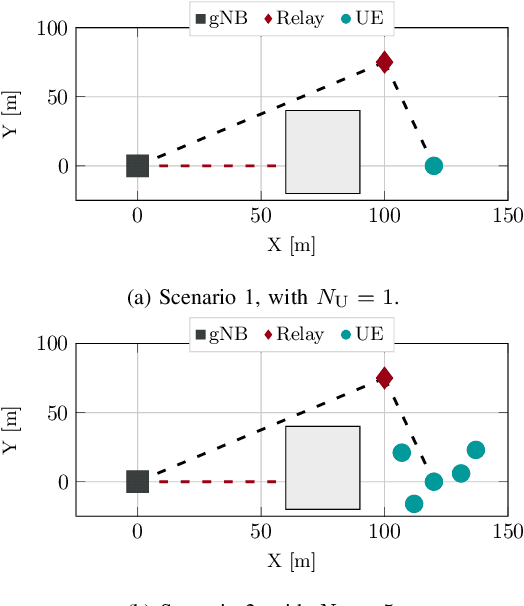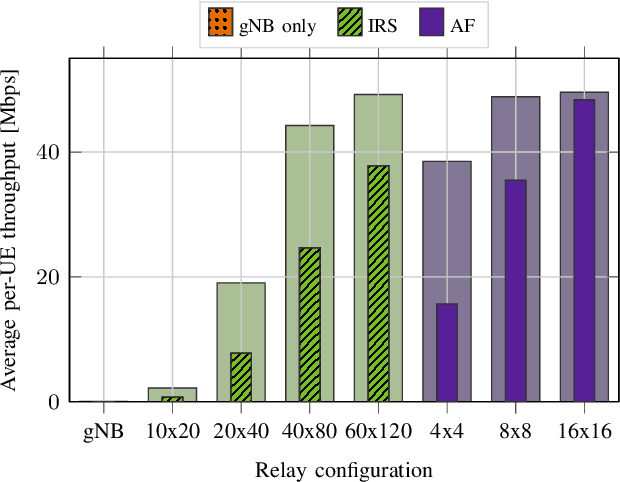Federico Moretto
Department of Information Engineering, University of Padova, Italy
Downlink TDMA Scheduling for IRS-aided Communications with Block-Static Constraints
Jan 25, 2023



Abstract:Intelligent reflecting surfaces (IRSs) are being studied as possible low-cost energy-efficient alternatives to active relays, with the goal of solving the coverage issues of millimeter wave (mmWave) and terahertz (THz) network deployments. In the literature, these surfaces are often studied by idealizing their characteristics. Notably, it is often assumed that IRSs can tune with arbitrary frequency the phase-shifts induced by their elements, thanks to a wire-like control channel to the next generation node base (gNB). Instead, in this work we investigate an IRS-aided time division multiple access (TDMA) cellular network, where the reconfiguration of the IRS may entail an energy or communication cost, and we aim at limiting the number of reconfigurations over time. We develop a clustering-based heuristic scheduling, which optimizes the system sum-rate subject to a given number of reconfigurations within the TDMA frame. To such end, we first cluster user equipments (UEs) with a similar optimal IRS configuration. Then, we compute an overall IRS cluster configuration, which can be thus kept constant while scheduling the whole UEs cluster. Numerical results show that our approach is effective in supporting IRSs-aided systems with practical constraints, achieving up to 85% of the throughput obtained by an ideal deployment, while providing a 50% reduction in the number of IRS reconfigurations.
End-to-End Simulation of 5G Networks Assisted by IRS and AF Relays
Mar 04, 2022



Abstract:The high propagation and penetration loss experienced at millimeter wave (mmWave) frequencies requires ultra-dense deployments of 5th generation (5G) base stations, which may be infeasible and costly for network operators. Integrated Access and Backhaul (IAB) has been proposed to partially address this issue, even though raising concerns in terms of power consumption and scalability. Recently, the research community has been investigating Intelligent Reflective Surfaces (IRSs) and Amplify-and-Forward (AF) relays as more energy-efficient alternatives to solve coverage issues in 5G scenarios. Along these lines, this paper relies on a new simulation framework, based on ns-3, to simulate IRS/AF systems with a full-stack, end-to-end perspective, with considerations on to the impact of the channel model and the protocol stack of 5G NR networks. Our goal is to demonstrate whether these technologies can be used to relay 5G traffic requests and, if so, how to dimension IRS/AF nodes as a function of the number of end users.
Maximum-Rate Optimization of Hybrid Intelligent Reflective Surface and Relay Systems
Sep 17, 2021



Abstract:We consider a wireless communication system, where a transmitting source is assisted by both a reconfigurable intelligent reflecting surface (IRS) and a decode-and-forward half-duplex relay (hybrid IRS-relay scheme) to communicate with a destination receiver. All devices are equipped with multiple antennas, and transmissions occur in two stages. In stage 1, the source splits the transmit message into two sub-messages, transmitted to the destination and the relay, respectively, using block diagonalization to avoid interference. Both transmissions will benefit from the IRS. In stage 2, the relay re-encodes the received sub-message and forwards it (still through the IRS) to the destination. We optimize power allocations, beamformers, and configurations of the IRS in both stages, in order to maximize the achievable rate at the destination. We compare the proposed hybrid approach with other schemes (with/without relay and IRS), and confirm that high data rate is achieved for the hybrid scheme in case of optimal IRS configurations.
 Add to Chrome
Add to Chrome Add to Firefox
Add to Firefox Add to Edge
Add to Edge